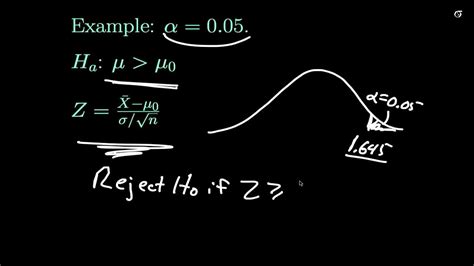Introduction
In statistical hypothesis testing, a rejection region is a range of values for a test statistic that leads to the rejection of the null hypothesis. Finding the rejection region is crucial for making accurate decisions about the validity of a hypothesis. This article provides a step-by-step guide on how to find a rejection region, along with examples and practical applications.

Step 1: State the Null and Alternative Hypotheses
The first step in finding a rejection region is to state the null (H0) and alternative (Ha) hypotheses. The null hypothesis represents the claim being tested, while the alternative hypothesis represents the alternative scenario that is considered true if the null hypothesis is rejected.
Step 2: Determine the Level of Significance (α)
The level of significance (α) is the probability of rejecting the null hypothesis when it is actually true (Type I error). A common choice for α is 0.05, which means that there is a 5% chance of rejecting the null hypothesis falsely.
Step 3: Find the Critical Value
The critical value is the value of the test statistic that separates the rejection region from the acceptance region. The critical value is determined based on the level of significance (α), the degrees of freedom (df), and the distribution of the test statistic.
For a Two-Tailed Test:
If the alternative hypothesis is two-tailed (i.e., Ha: μ ≠ μ0), the critical value is found using the following formula:
Critical Value = ± t(1 - α/2, df)
where:
- t(1 – α/2, df) is the t-value with area α/2 in the upper tail of the t-distribution with df degrees of freedom
For a One-Tailed Test:
If the alternative hypothesis is one-tailed (i.e., Ha: μ < μ0 or Ha: μ > μ0), the critical value is found using the following formula:
Critical Value = ± t(1 - α, df)
where:
- t(1 – α, df) is the t-value with area α in the upper tail of the t-distribution with df degrees of freedom
Step 4: Determine the Rejection Region
The rejection region consists of all values of the test statistic that are either less than the lower critical value or greater than the upper critical value. In other words, the rejection region is:
Rejection Region: Test Statistic < Lower Critical Value OR Test Statistic > Upper Critical Value
Example
Let’s consider an example:
- H0: μ = 10
- Ha: μ ≠ 10
- α = 0.05
- df = 20
Using the formula for a two-tailed test, the critical values are:
Critical Values = ± t(1 - 0.025, 20) = ± 2.093
Therefore, the rejection region is:
Rejection Region: Test Statistic < -2.093 OR Test Statistic > 2.093
Practical Applications
Finding a rejection region has numerous applications in various fields:
- Medical Research: Determining the effectiveness of a new treatment by comparing it to a standard treatment.
- Product Testing: Evaluating the quality of a product by comparing it to a reference standard.
- Social Science Research: Testing hypotheses about social phenomena, such as the relationship between education and income.
- Business Analytics: Making decisions based on data, such as determining the optimal marketing strategy or predicting customer behavior.
Conclusion
Finding a rejection region is a fundamental step in hypothesis testing. By following the steps outlined in this article, researchers and analysts can accurately determine the rejection region and make informed decisions about the validity of their hypotheses. The applications of rejection regions are vast, enabling us to draw valuable conclusions from statistical data in various fields.
